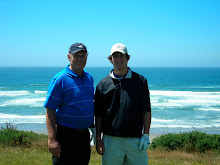There, in a nutshell, is the essence of Macdonald's approach to golf architecture. He didn't design courses that dictate what a golfer must do. Strange to say, this big, blustery man with the big, blustery ego, a man who seems to have enjoyed telling others what to do, understood that the designer of a golf course had to stand back. He couldn't bark orders. He had to provide golfers the opportunity to make their own decisions about how to play a course.
Given how Macdonald began his quest to build an ideal course, this was by no means an inevitable conclusion. His interest had been piqued by an article in a 1901 volume of Golf Illustrated which posed the question: Which Are the Most Difficult Holes in the World?
Many leading players answered the question, and many holes that made the list are today regarded as iconic. The Road hole, of course. The Redan. The Alps, the Long, the Eden.
Macdonald decided to use these tried-and-tested holes as his models, but the genius of his plan was to recognize that he needn't produce exact replicas. The thrill of playing the Alps wasn't just hitting a ball over a high hill (though there is joy in it!). No, the full satisfaction came from playing the hole successfully from tee to green, from choosing a method of attack and executing it as planned.
Macdonald and his associate/successor Seth Raynor built many courses that have become American classics, and they stuck to their repertory of holes. If you just read the names of the holes that appear on many of their course -- Redan, Long, Road, Short, Punch Bowl, Short, Biarritz, Cape -- you could easily conclude that they didn't have much imagination. They seemed to build the same hole over and over.
But when you actually see these holes, you realize how how much variation there can be from course to course. Just look at the two shots of the Redans here. Actually, since you can't see much in either of the pictures, I'll have to ask you to take me at my word. The top one is the Redan at the Chicago Golf Club, and the picture doesn't really do justice to the size of the green which stands high in its flat surroundings. This green looks like the roof of a house.The lower shot is of the Redan at National. Standing on the tee, you see just a sliver of green with the rest sloping away. They're both intimidating shots, but the Chicago Redan intimidates but showing you the wild slope of the green; the Redan at National intimidates by not revealing all of its dangers.
.jpg)
The Redan is probably the most frequently imitated hole in golf. For Macdonald's views on the hole, hit the link "Consider the Redan." And I can't resist adding that the hole was named for a fortress in Russia that was besieged by British forces during the Crimean War. Manned by Russian artillery, the "Great Redan" acquired a reputation as an impregnable fortification. The image at the right is from the Museum at Sebastopol.
.jpg)
The Redan is probably the most frequently imitated hole in golf. For Macdonald's views on the hole, hit the link "Consider the Redan." And I can't resist adding that the hole was named for a fortress in Russia that was besieged by British forces during the Crimean War. Manned by Russian artillery, the "Great Redan" acquired a reputation as an impregnable fortification. The image at the right is from the Museum at Sebastopol.







No comments:
Post a Comment